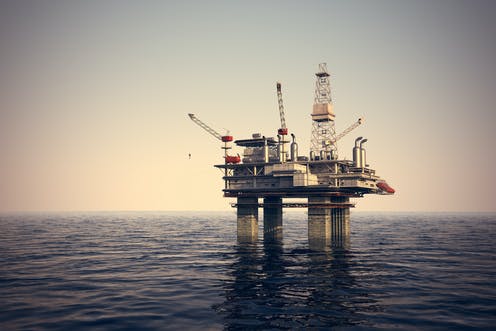Why we should leave old oil rigs in the sea – and why we don’t
12 octobre 2020
12 octobre 2020

Decommissioning the UK’s offshore oil and gas infrastructure will cost the taxpayer £24 billion, according to estimates from HMRC. So why can’t we leave man-made structures in the sea and thereby save the cost of removal and recycling? That would be a big win for the public purse. However, to do that, we would have to test the pillars of sustainability: the economy, environment and society.
Decommissioning an oil rig is a big job. Offshore installations consist of the equipment for oil and gas processing and drilling (the topsides), and the supporting seabed-to-surface structure. This is most often a steel frame, piled to the seabed (the jacket). The largest steel jacket in UK waters is that of the Magnus oil platform, which weighs 30,000 tonnes – around the weight of 20,000 family cars.
Removal is typically undertaken in two stages. First, the topsides equipment is cleaned and broken into sections for lifting onto crane barges or, for heavier topsides structures, a double-hulled tanker. Once the topsides has been removed, the jacket is cut, lifted onto a barge and both topsides and jacket are taken onshore for dismantling and recycling.
The oil and gas wells always need to be plugged to prevent the contents of the abandoned hydrocarbon reservoir leaking into the surrounding environment. But there is ever-growing evidence that leaving the jacket and topside structures in the sea are an environmental positive.
In the Gulf of Mexico, the US programme Rigs to Reefs has turned 532 oil and gas platforms into artificial reefs. After several years in the water, each structure becomes covered by epifaunal organisms such as oysters, mussels, barnacles, tunicates, sponges and corals. These create an increasingly complex surface that provides thousands of nooks and crannies for organisms such as crabs, worms, sea urchins and blennies to use. These animals then provide food for larger fishes and the structure becomes a true reef ecosystem.
The Scottish Wildlife Trust is also proposing that architecture removal may not be the best environmental option. Similar to the Gulf of Mexico, structures off the coast of Scotland provide hard surfaces that are colonised by anemones, hydroids, bryozoans, sponges, mussels, barnacles, and soft and hard corals. They have also become breeding grounds and shelter for commercially important fish and they attract predatory marine mammals.
Decommissioning, on the other hand, destroys thriving marine ecosystems that have built up over decades. It also results in increased harmful air emissions, including greenhouse gas emissions, from the marine traffic required to conduct the removal works.
Decommissioning offers few social or economic benefits either. It creates few jobs, particularly for the onshore dismantling and recycling parts of the process. For example, removing the Buchan floating production facility provided just 35 jobs. And at the end of the process, nothing is left. Ultimately, decommissioning is a drain on taxpayer funds.
Source : The Conversation